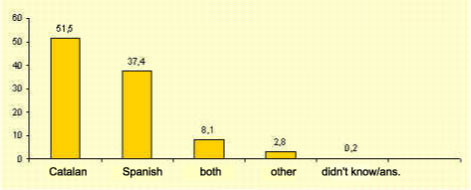
| Sociolingüística catalana |
| Winter 2001 |
| Linguistic uses and identity in
Catalonia, by Albert Fabà, Olga Gàlvez, Joan Manrúbia and Noemí Ubach |
||||
| The data presented in this article have been taken from the results of the sociolinguistic survey co-ordinated by the authors on the linguistic knowledge, identity, uses and attitudes of the population of Catalonia as a whole. The survey was conducted during the first term of the year 2000, after which were performed the main intersections and a factorial and cluster analysis. (1) However, in this article, we will limit ourselves to presenting some aspects of linguistic uses and identity in Catalonia proper. This work forms part of the study entitled "Entre l’esperança i el neguit. El català a Catalunya", (Between hope and anxiety. Catalan in Catalonia), also by the authors of this article, which was awarded joint first prize in the Jaume Camps Award for Sociolinguistics in November of this year. We have included diagrams from the 1997 DYM survey in order to make intersections on the variable of age. | |||
| Contents
3.
"Non-domestic" uses 1. Linguistic Identity The numerous investigations performed over the last fifteen years have asked a series of questions with a varying degree of relevance to this area. The formulations used include: language of origin (Line Staff 1992); main language (metropolitan survey 1986 and CIS 1993); do you consider yourself more Spanish-speaking or more Catalan-speaking? (CIS 1998); habitual language (DYM 1997 and 1999); mother tongue (CIS 2001) and, which do you consider to be your language? (metropolitan survey, 1990, 1995 and 2000). The formulation that we believe to be most appropriate for finding out the linguistic identity of the population is this latter, used in the last three editions of the metropolitan survey. The results are shown in Figure 1 below. Figure 1. Which do you consider to be your language? 2000. Percentages
The bilingual group had already appeared in the various editions of the metropolitan survey –of the years 1990 and 1995, as the 1986 survey used a different formulation: "What is your main language?". A significant change took place between the 1986 and 1990 surveys: this new group emerged, apparently causing a drop in the group of individuals who considered that their language was Spanish alone. This has led certain analysts to conclude that this change reflected a real tendency, although they still maintained that the change in the formulation of the question could also be an important factor. As far as we are concerned, this change in formulation was the main factor causing the contrast in the data. However, it is quite possible that, objectively-speaking, a sociolinguistic phenomenon of this nature has indeed occurred over the last twenty-five years: a drop in the population who saw themselves as solely Spanish-speaking and, in contrast, the emergence of a small bilingual sector, whilst the percentage of Catalan-speakers has remained the same. This merits some discussion. The question on domestic language asked in 1975 by a team led by Modest Reixach, albeit only within the province of Barcelona, could provide us with a clue as regards this last aspect (maintenance of the proportion of Catalan-speakers), given the sociolinguistic situation at the end of the Franco era. Miquel Strubell’s extrapolation of these data for Catalonia as a whole placed the number of citizens of Catalonia who considered Catalan to be their domestic language at 47.87%. (2) This figure is very similar to the 52% of the population who today state their language to be Catalan. (3) |
